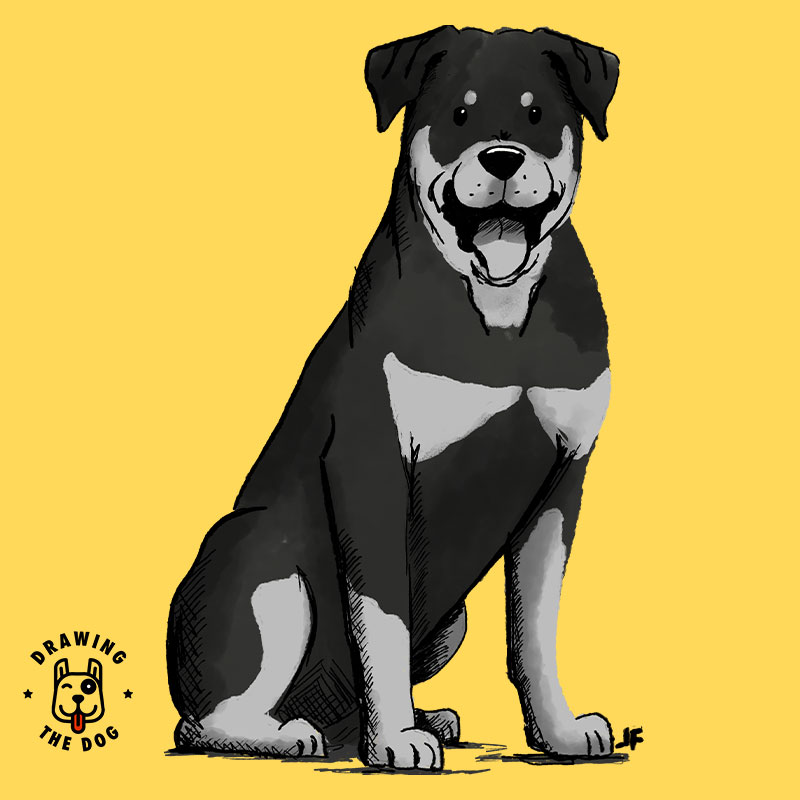Rottweiler 101 – A Guide To Rotties

Everything you need to know about the remarkable Rottweiler breed.
Rottweilers are one of the most loyal, intelligent, and hardworking dog breeds in the world. Known for their protective nature and big hearts, Rottweilers are more than just pets—they’re family. Whether you’re a current owner or considering adopting, this guide offers everything you need to know about caring for and understanding these amazing dogs. And please check out our illustrated Rottweiler prints and gifts in the shop.
Rottweiler Quick Facts
| Origin: | Roman Empire, further refined in Germany |
| Size: | 56–69 cm (22–27 in) at the shoulder |
| Weight: | 35–60 kg (77–132 lbs) |
| Activity Level: | High |
| Barking/Howling Level: | Moderate |
| Good with Dogs: | Yes, with proper socialization |
| Good with Kids: | Excellent, but supervision is needed for young children |
| Good with Cats: | Possible with early training |
| Shedding: | Moderate |
| Grooming Level: | Low |
| Training Level: | High (eager to learn with consistent training) |
What Makes Rottweilers Special?
Rottweilers are known for their striking appearance and even more remarkable personalities. Their muscular build, shiny black coat with rust markings, and soulful brown eyes make them instantly recognizable. But beyond their looks, Rottweilers are renowned for their courage, loyalty, and intelligence. They thrive when given a job, protecting your home, competing in agility sports, or being your exercise companion.
History of the Rottweiler Breed
The roots of the Rottweiler date back to the Roman Empire, where they were used as herding dogs for livestock. As the Roman legions marched across Europe, these ancestors of the Rottweiler were key in managing herds. In Germany, the breed evolved into the robust dog we know today, often used by butchers to pull carts and protect property. Their versatility has since earned them roles in law enforcement, search and rescue, and as cherished family members.
Physical Characteristics of Rottweilers
Rottweilers are medium to large-sized dogs with a robust, athletic frame. Males typically stand between 61–69 cm (24–27 in), while females measure 56–63 cm (22–25 in). They weigh 35–60 kg (77–132 lbs) depending on size and gender. Their double coat is short, with a sleek black base complemented by rust-coloured markings around their face, chest, and legs.
Temperament and Personality Traits
Rottweilers are often misunderstood, but those who know them will tell you about their playful, loving side. They form deep bonds with their families and are protective without being overly aggressive. Early training and socialization are key to managing their naturally confident demeanour. These dogs are also very intelligent and love mental stimulation, making puzzle toys and training sessions excellent activities.
Training Rottweilers
Training a Rottweiler requires patience and consistency. Start with early socialization to expose your pup to new people, environments, and other animals. Positive reinforcement techniques, such as treats and praise, work best. Since Rottweilers can sometimes be strong-willed, training should focus on establishing you as a confident and kind leader.
Rottweilers and Families
Rottweilers can be excellent family dogs. They’re naturally gentle with children but may not realize their size, so supervision with smaller kids is essential. They can get along with other pets with proper introductions, but their protective instincts might initially make them wary of strangers or unfamiliar animals.
Rottweilers as Working Dogs
Historically, Rottweilers have thrived in roles requiring strength, intelligence, and determination. Today, they excel in roles such as police work, search-and-rescue missions, and even therapy. Their strong work ethic makes them highly adaptable to tasks requiring focus and energy.
Common Health Issues in Rottweilers
Like all breeds, Rottweilers are prone to certain health problems. Hip dysplasia, heart conditions, and joint issues are the most common. Regular vet check-ups, a balanced diet, and maintaining an appropriate weight are essential for their health.
Dietary Needs and Nutrition
A Rottweiler’s diet should be tailored to its size and activity level. High-quality dog food rich in protein and healthy fats is essential. Puppies will need more frequent meals, while adult Rottweilers do well with two meals per day. Be mindful of portion sizes to avoid obesity, which can exacerbate joint issues.
Exercise and Physical Activity
Rottweilers are energetic dogs that require at least 90 minutes of exercise daily. Activities like jogging, hiking, and agility training help keep them physically and mentally stimulated. Without enough activity, they can become bored, which may lead to destructive behaviours.
Grooming and Maintenance
Rottweilers are relatively low-maintenance when it comes to grooming. Weekly brushing is usually enough to manage their moderate shedding. During seasonal shedding periods, brushing may need to be more frequent. Regular ear cleaning, nail trimming, and dental care are essential parts of their routine.
Art Prints For Rottie Lovers
As a proud Rottweiler owner, why not showcase your love for this magnificent breed with art prints? Illustrated Rottweiler wall art and gifts make wonderful additions to your home or as thoughtful presents for other dog lovers. Browse our collection of Rottweiler-inspired gifts here and find something that captures the heart of this amazing breed.
Adopting or Buying a Rottweiler
If you’re considering a Rottweiler, adoption from a rescue organization is a fantastic option. Many Rottweilers in shelters are looking for loving homes. If buying from a breeder, ensure they are reputable, with health certifications for their breeding dogs.
Legal Considerations for Rottweiler Ownership
Rottweilers are subject to breed-specific legislation (BSL) in some regions. Before adopting, check local laws regarding licensing, insurance requirements, or restrictions. Responsible ownership and proper training can help combat unfair stereotypes about the breed.
FAQs about Rottweilers
How much exercise do Rottweilers need?
Rottweilers require at least 90 minutes of exercise daily to stay healthy and happy.
Are Rottweilers good with children?
Yes, they are excellent family dogs but should always be supervised around younger kids due to their size.
Do Rottweilers shed a lot?
Rottweilers have moderate shedding, which can be managed with weekly brushing.
Can Rottweilers live with cats?
With early socialization and training, Rottweilers can coexist with cats.
What are common health issues in Rottweilers?
Hip dysplasia, heart issues, and obesity are the most common health concerns.
Are Rottweilers aggressive?
No, Rottweilers are naturally protective and loyal but are not aggressive with proper training.
Conclusion
Rottweilers are an extraordinary breed that blends intelligence, loyalty, and strength. They require dedicated care, training, and love to thrive, but the rewards of owning a Rottweiler are immeasurable. Whether you’re an experienced owner or considering adoption, the key is understanding their unique needs and celebrating everything that makes them special.







